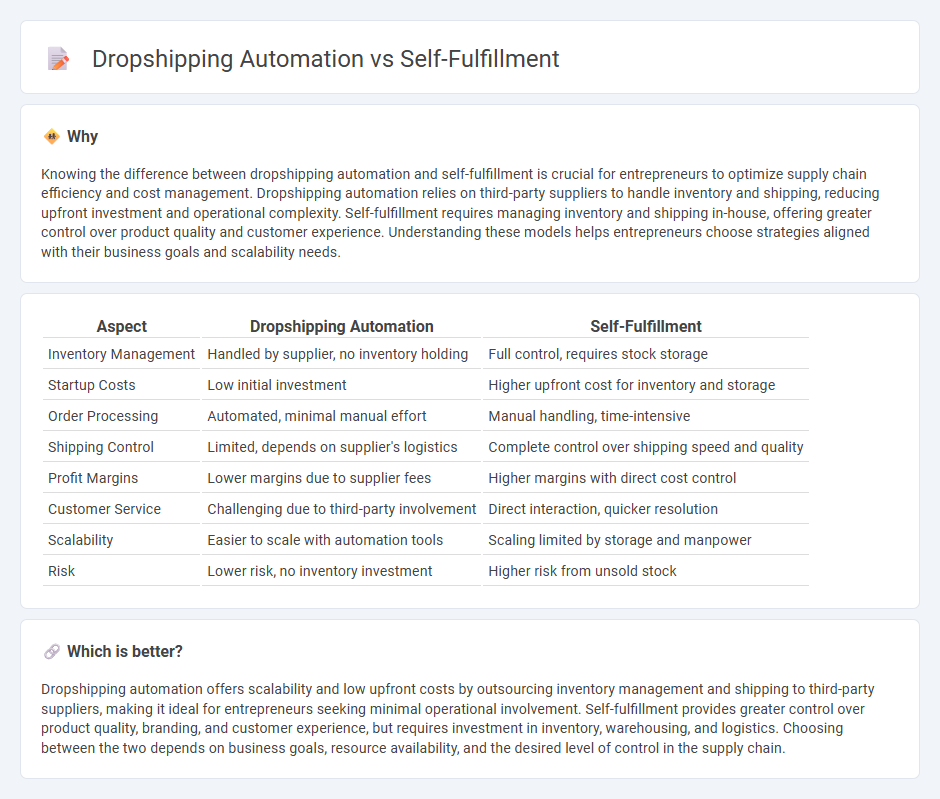
Dropshipping automation streamlines inventory management and order processing by partnering with suppliers who ship directly to customers, reducing overhead and minimizing upfront costs. Self-fulfillment entails storing, packing, and shipping products independently, offering greater control over quality and customer experience but demanding more time and resources. Explore the pros and cons of each approach to determine the best fit for your entrepreneurial goals.
Why it is important
Knowing the difference between dropshipping automation and self-fulfillment is crucial for entrepreneurs to optimize supply chain efficiency and cost management. Dropshipping automation relies on third-party suppliers to handle inventory and shipping, reducing upfront investment and operational complexity. Self-fulfillment requires managing inventory and shipping in-house, offering greater control over product quality and customer experience. Understanding these models helps entrepreneurs choose strategies aligned with their business goals and scalability needs.
Comparison Table
| Aspect | Dropshipping Automation | Self-Fulfillment |
|---|---|---|
| Inventory Management | Handled by supplier, no inventory holding | Full control, requires stock storage |
| Startup Costs | Low initial investment | Higher upfront cost for inventory and storage |
| Order Processing | Automated, minimal manual effort | Manual handling, time-intensive |
| Shipping Control | Limited, depends on supplier's logistics | Complete control over shipping speed and quality |
| Profit Margins | Lower margins due to supplier fees | Higher margins with direct cost control |
| Customer Service | Challenging due to third-party involvement | Direct interaction, quicker resolution |
| Scalability | Easier to scale with automation tools | Scaling limited by storage and manpower |
| Risk | Lower risk, no inventory investment | Higher risk from unsold stock |
Which is better?
Dropshipping automation offers scalability and low upfront costs by outsourcing inventory management and shipping to third-party suppliers, making it ideal for entrepreneurs seeking minimal operational involvement. Self-fulfillment provides greater control over product quality, branding, and customer experience, but requires investment in inventory, warehousing, and logistics. Choosing between the two depends on business goals, resource availability, and the desired level of control in the supply chain.
Connection
Dropshipping automation streamlines order processing by integrating supplier systems, reducing manual tasks and improving efficiency. Self-fulfillment enables entrepreneurs to maintain control over inventory and shipping, ensuring faster delivery and personalized customer service. Combining dropshipping automation with self-fulfillment leverages technology to optimize supply chain management, balancing scalability with quality control in ecommerce entrepreneurship.
Key Terms
Personal Passion
Self-fulfillment in e-commerce nurtures personal passion by allowing entrepreneurs to curate and deliver products that resonate with their values and creativity, enhancing customer satisfaction through direct involvement. Dropshipping automation prioritizes efficiency and scalability, often distancing business owners from the tactile experience of product handling and personal brand development. Explore deeper insights on aligning business models with personal passion to achieve sustainable growth and fulfillment.
Passive Income
Self-fulfillment in e-commerce requires hands-on management of inventory, order processing, and shipping, which limits the potential for truly passive income. Dropshipping automation streamlines these tasks by outsourcing order fulfillment to suppliers and integrating software, enabling entrepreneurs to generate passive income with minimal direct involvement. Explore advanced dropshipping automation strategies to maximize your passive income potential.
Scalability
Self-fulfillment allows direct control over inventory and customer service but can limit scalability due to manual handling constraints. Dropshipping automation leverages third-party suppliers and software integration, enabling rapid expansion with minimal overhead and reduced operational complexity. Explore detailed strategies to maximize scalability in both models and determine the best fit for your business growth.
Source and External Links
Self-Fulfillment Definition, History & Importance - Study.com - Self-fulfillment is the ability to make oneself happy by meeting personal goals, involving self-reflection and aligning life with one's values for a deep sense of achievement distinct from temporary happiness.
The Ideal of Self-Fulfillment - Princeton University - Self-fulfillment is seen as a flourishing completion of one's potential and aspirations, representing a deeply satisfying and worthwhile life, though it can involve internal conflicts about which aspects of the self to fulfill.
Self-fulfillment - Wikipedia - Self-fulfillment in philosophy and psychology refers to realizing one's deepest desires and capacities, tracing its historical conceptual development across cultures and thinkers.
 dowidth.com
dowidth.com